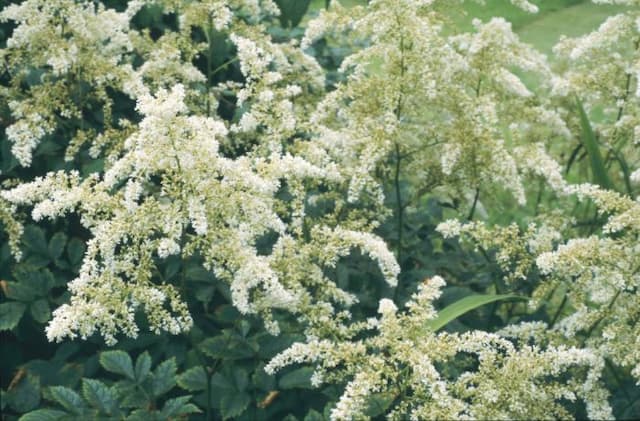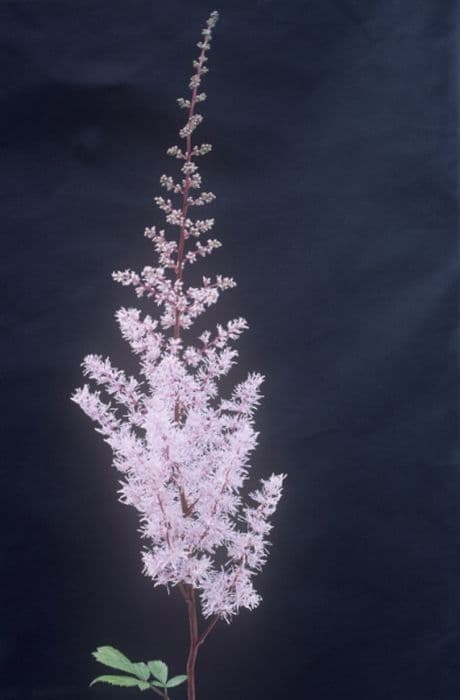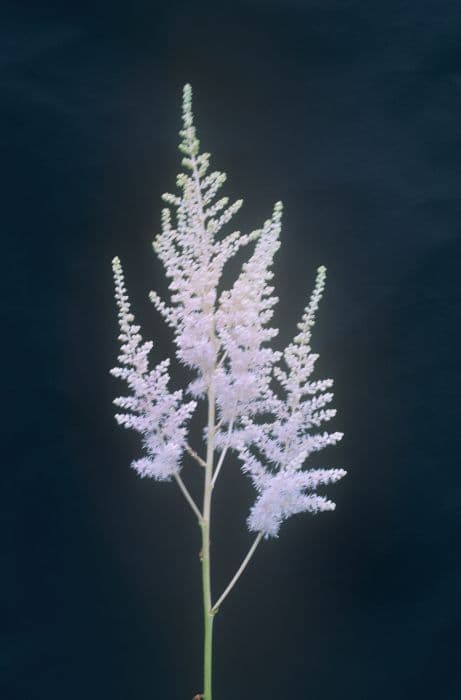Alum root 'Peach Flambé' Heuchera 'Peach Flambé' (PBR)

ABOUT
'Peach Flambé' is a semi-evergreen cultivar, whose spring leaves emerge as orange, toning down later to peach shades and becoming purple in winter. Leaves have mottled veining and are rounded, lobed and ruffled in shape. Dainty panicles of cream flowers are borne in mid spring to early summer
About this plant
 Names
NamesSynonyms
Coral Bells, Alumroot.
Common names
Heuchera 'Peach Flambé' (PBR)
 Characteristics
CharacteristicsLife cycle
Perennials
Foliage type
Evergreen
Color of leaves
Mixed
Flower color
White
Height
1 foot 6 inches (45.72 cm)
Spread
1 foot 6 inches (45.72 cm)
Plant type
Herb
Hardiness zones
4
Native area
North America
Benefits
 General Benefits
General Benefits- Attractive foliage: Heuchera 'Peach Flambé' has vibrant peach to plum-colored leaves that add striking color contrast in gardens and landscapes.
- Low maintenance: This plant requires minimal care once established, making it suitable for gardeners of all skill levels.
- Drought tolerant: Once established, it can withstand periods of drought, reducing the need for frequent watering.
- Long blooming period: It produces delicate flowers that bloom from late spring into summer, providing a long season of visual interest.
- Compact size: With its relatively small size, it fits well in smaller gardens, borders, or as ground cover.
- Versatile uses: Suitable for mixed beds, containers, rock gardens, and as an underplanting for larger shrubs or trees.
- Attracts pollinators: The flowers attract butterflies and hummingbirds, which can help pollinate other plants in the garden.
- Deer and rabbit resistant: The plant is less likely to be eaten by deer and rabbits, protecting your garden from damage.
- Year-round interest: Even when not in bloom, the foliage provides year-round visual appeal due to its evergreen or semi-evergreen nature in mild climates.
 Medical Properties
Medical PropertiesThis plant is not used for medical purposes.
 Air-purifying Qualities
Air-purifying QualitiesThis plant is not specifically known for air purifying qualities.
 Other Uses
Other Uses- Art and Craft Inspiration: The vibrant peach to plum-colored foliage of Coral Bells can inspire artists and crafters in their work, guiding color palettes in paintings, textile designs, or home decor projects.
- Photography Subject: With its unique and attractive leaves, Coral Bells can be used as a stunning subject for macro and nature photography, helping photographers to add a pop of color to their portfolios.
- Educational Tool: Coral Bells can be used in schools or educational programs to teach students about plant biology, hybridization, and horticultural practices.
- Culinary Garnish: While not common, the leaves of Coral Bells can be used as a garnish for culinary presentations due to their colorful appearance, provided that the particular variety is known to be non-toxic.
- Ikebana: Coral Bells' foliage can be incorporated into Japanese ikebana arrangements, where their shapely leaves and colors contribute to the art's balance and harmony.
- Petal Confetti: The flowers of Coral Bells, once dried, can be used as natural, biodegradable confetti for eco-friendly celebrations like weddings or garden parties.
- Seasonal Displays: The leaves of Coral Bells can be included in fall decor arrangements, alongside pumpkins, gourds, and dried corn, reflecting the warm hues of the season.
- Landscape Theme Work: Coral Bells can be used to create themed landscape designs, like a 'peach orchard' corner in a garden, with other peach-flowered or foliage plants.
- Scent Garden Component: Although not known for a strong scent, Coral Bells can contribute to a sensory garden that emphasizes texture and color contrasting with fragrant plants.
- Fantasy Garden Design: With their fairy-tale-like appearance, Coral Bells are perfect for creating a fantasy-themed garden space, evoking an enchanted forest vibe.
Interesting Facts
 Feng Shui
Feng ShuiThe Coral Bells is not used in Feng Shui practice.
 Zodiac Sign Compitability
Zodiac Sign CompitabilityThe Coral Bells is not used in astrology practice.
 Plant Symbolism
Plant Symbolism- Adaptability - Heuchera 'Peach Flambé', commonly known as Coral Bells, can thrive in a variety of climates and conditions, symbolizing the ability to adapt and succeed in different environments.
- Unity and Harmony - The mounding habit of Coral Bells and how its flowers stand together on tall stalks can represent unity, bringing diverse elements together in harmony.
- Lasting Beauty - With its perennial nature and visually appealing foliage that changes color with the seasons, Coral Bells symbolize enduring and lasting beauty.
- Health and Vitality - The vibrant colors of the 'Peach Flambé' variety, ranging from peach to plum, are often associated with health, vitality, and rejuvenation.
- New Beginnings - Coral Bells bloom in late spring or early summer, which is a time traditionally associated with new beginnings and fresh starts.
 Water
WaterCoral Bells should be watered thoroughly when the top inch of soil feels dry to the touch, which typically happens about once a week. During hot, dry periods, watering frequency may need to increase to twice a week. It's important to water the plant directly at the soil level, avoiding wetting the foliage, to prevent fungal diseases. Provide about 1 gallon of water per plant at each watering to ensure the root zone is sufficiently moistened. In the winter, when the plant is dormant, reduce watering to every other week or less, depending on the moisture level of the soil.
 Light
LightCoral Bells thrive best in part shade, where they receive filtered sunlight or a few hours of morning sun followed by afternoon shade. They can tolerate full shade, but their foliage color may not be as vibrant. If planted in full sun, the leaves may scorch, especially in hot summer climates, so a spot that offers protection from intense midday sunlight is optimal.
 Temperature
TemperatureCoral Bells prefer a temperature range of 60°F to 70°F but can tolerate temperatures as low as 0°F and as high as 80°F. They are generally hardy in USDA zones 4 through 9, making them versatile for various climate conditions. It's important to provide a layer of mulch for insulation if temperatures dip below freezing in winter.
 Pruning
PruningPrune Coral Bells primarily to remove any dead or damaged leaves and to promote air circulation, which can help prevent disease. Pruning is best done in the spring before new growth begins. Trim away any old, tattered foliage and spent flower stalks with clean, sharp shears. Regularly deadheading the spent flowers during the blooming season can also encourage more blooms.
 Cleaning
CleaningAs needed
 Soil
SoilCoral Bells prefer a well-draining soil mix with a high content of organic matter. A mix of garden soil, peat moss or coconut coir, and perlite or vermiculite works well. Aim for a soil pH between 6.0 to 7.0 for optimal growth.
 Repotting
RepottingCoral Bells do not need frequent repotting; every 3 to 4 years is sufficient, or when the plant has outgrown its pot.
 Humidity & Misting
Humidity & MistingCoral Bells thrive in moderate humidity levels but are tolerant of a wide range; aim for a humidity level around 40-50%.
 Suitable locations
Suitable locationsIndoor
Place Coral Bells in bright, indirect light indoors.
Outdoor
Grow Coral Bells outdoor in partial shade and moist soil.
Hardiness zone
4-9 USDA
 Life cycle
Life cycleThe life of a 'Peach Flambé' Coral Bells begins with seed germination, typically occurring in warm spring soil conditions. Once the seedlings develop, they progress to form a rosette of ruffled leaves, showcasing hues of peach to plum as they mature. Throughout the growing season, the plant sends up slender stalks topped with tiny bell-shaped flowers, attracting pollinators. After flowering, some varieties may set seed, which can be dispersed to generate new plants. The plant is a perennial, with foliage often persisting in mild climates through the winter, though it may die back in colder regions. Each spring, 'Peach Flambé' Coral Bells rejuvenates, forming new foliage and repeating its growth cycle.
 Propogation
PropogationPropogation time
Spring to early summer
The most popular method for propagating Heuchera 'Peach Flambé', commonly known as Coral Bells, is by division. This typically takes place in the spring or early fall. To do this, the clump of the plant is carefully dug up and divided into smaller sections, ensuring that each new piece has at least one growing point or bud. The divisions are then replanted immediately in soil that has good drainage and is rich in organic matter. The planting depth should be such that the crown of the plant (where the stems meet the roots) is just at or slightly above the soil level to encourage healthy growth and prevent rotting. It's essential to keep the newly planted divisions well-watered until they are established, which can take a few weeks to a few months depending on environmental conditions. Division allows the Coral Bells to maintain their vigor and also increases the number of plants in the garden or allows for sharing with fellow gardeners.









